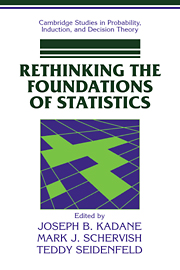Introduction
Published online by Cambridge University Press: 05 June 2012
Summary
In the seventeen years between the first (1954) and second (1971) editions of his book The Foundations of Statistics, Savage reported a change in the“climate of opinion” about foundations. That change, he said,“would obliterate rather than restore” his earlier thinking about the relationship between the two major schools of statistics that were the subject of his inquiry. What in the early 1950s started out for Savage as a task of building Bayesian expected utility foundations for common, so-called Frequentist statistics – which for Savage included the Fisher-Neyman-Pearson-Wald program that was dominant in the British-American school from the 1930s – revealed itself, instead, to be an impossibility. Contrary principles separated Bayesian decision theory from what practicing statisticians of the day were taught to do. Significance tests, tests of hypotheses, and confidence intervals give quantitative indices, such as confidence levels, that only accidentally and approximately cohere with the Bayesian theory that Savage hoped might elucidate and justify them.
Since the second edition of The Foundations of Statistics and Savage's premature death (both in 1971), we have come to understand much better the extent of the conflict between Bayesian and Frequentist statistical principles of evidence. Some limitations in Frequentist methods, which existed only in the lore of practicing statisticians, gained theoretical footing through the Bayesian point of view. Consider the very general problem of how, within the Frequentist program, to deal with conditional inference, e.g., whether or not to condition on an ancillary statistic.
- Type
- Chapter
- Information
- Rethinking the Foundations of Statistics , pp. 1 - 14Publisher: Cambridge University PressPrint publication year: 1999

